John Norquist Milwaukee Tour – Congress for the New Urbanism
One day before the start of the Congress for the New Urbanism (CNU) 19th annual conference in Madison, former Mayor and current CNU President & CEO John Norquist returned to Milwaukee with a number of his former deputies to offer a tour of many of the urban projects started during his tenure as mayor.
Third Ward
After Park’s introduction, John Norquist lead attendees on a tour of the Historic Third Ward, a neighborhood just south of downtown composed of restored warehouses and infill development. The first stop on the tour was in front of Mandel’s Corcoran Lofts apartments where Barry Mandel gave a brief overview of the development noting that 77% of the residents have come from outside the City of Milwaukee and that the his firm has found that green roofs can help generate a premium on rents. Mandel also noted that his firm hopes to break ground on a new project next to the Marine Terminal Lofts sometime next year.
Next it was off to Boris Gokhman‘s development, the 217-unit Jefferson Block Apartments. There Gokhman, a Ukrainain immigrant and painter turned developer, explained some of the struggles his firm, New Land Enterprises, had gone through in building the project, and some of the successes they have had. Tour attendees were shown the courtyard of the apartment complex, and Boris explained how New Land has integrated the courtyard into the street grid by allowing it to function as a pedestrian street, as well leveraging it as an amenity to residents.
After seeing the neighboring developments, the tour continued with Norquist leading the group to Broadway and explaining the historical function of the street. A discussion on design guidelines emerged following a question by tour attendee Alderman Nik Kovac with Norquist noting there were pros and cons to the Third Ward’s Architectural Review Board. Norquist expressed to Kovac that the North Avenue design review board warranted further discussion prior to implementation. After a short stop in Catalano Square (including a look at the recently restored and installed former streetcar stop shelter), it was on to the last leg of the tour.
The last leg of the Third Ward tour was a walk down the Milwaukee RiverWalk on the west edge of the Third Ward with Norquist and Park stopping the group to offer insights into the process to get the RiverWalk built. RiverWalk consultant Ken Kay, who worked on getting the Milwaukee RiverWalk off the ground through much of downtown, noted that the Third Ward stretch lacks sound urban design in many spots. Norquist was quick to reminisce about the challenges of that stretch, having worked with artist Mary Miss on this stretch whose original ideas were thought to be unsustainable and would serve only to attract flotsam and jetsam. Norquist also talked about his desire to put the Buffalo Street bridge back in place (after it was removed for cost-savings reasons), and how it would have served to activate the western side of the river (currently a gas station and a storage lot for USPS semi-trailers).
Milwaukee River
After lunch at the Milwaukee Public Market (a product of the 1999 downtown plan) and a brief speech by Common Council President Willie Hines, Jr., the tour took to the water on one of the Edelweis boats. Gary Grunau, the original business community backer of the Milwaukee RiverWalk, narrated much of the riverboat tour. Grunau, a Milwaukee real estate developer, reflected on the challenges he and Norquist faced in getting the project off the ground. Norquist noted how he met Ken Kay at CNU 1, which led to Kay becoming the consultant for the Milwaukee RiverWalk’s original development. As the boat stopped at Mason Street, Kay talked about his time consulting on the RiverWalk project and noted that its most important aspect is the connectivity it provides.
The boat idled where the former Park East Freeway spur crossed the Milwaukee River as Norquist and Grunau reminisced about how discussions with former Governor Tommy Thompson went when Norquist wanted to tear down the freeway, noting the plans for the Harley Museum at Grunau’s Schiltz Park development were the key to getting the ball rolling. Norquist noted how many of the city and privately-owned lots had been developed, while the county lots sit in empty, in large part because of aggressive demands for prevailing wages to be paid by developers. Barry Mandel also touched on his neighborhood-by-design development The North End, noting that he believed his firm had reached a consensus with the city on the next phase of the development.
Beerline B
The water-based portion of the trip ended at the Milwaukee Rowing Club in the Beerline B neighborhood located at the north end of the Milwaukee RiverWalk. The Beerline B neighborhood is one of the most visible vestiges of the Norquist administration, an urban neighborhood consisting of $87 million in development that replaced a rail line that previously served three downtown breweries.
Attendees disembarked the book to explore the neighborhood, ending with a presentation by Grace La of La Dallman who designed the Marsupial Bridge that hangs from the Holton Viaduct, providing a pedestrian connection for the Beerline B with the thriving Brady Street neighborhood. Law detailed some of the design and engineering challenges of the bridge, including the decision to build the bridge with concrete instead of steel.
Lakefront
After a bus tour of Brady Street and the Lower East Side, the tour group stopped at the Milwaukee Art Museum (affectionately known as “the Calatrava”) for a brief overview of the iconic lobby of the building. Then it was off to the final stop, the University Club Tower located just up the hill from the Art Museum.
University Club Tower
At the University Club Tower a panel consisting of Julie Penman, Barry Mandel, Boris Gokhman, and Gary Grunau all spoke on their views on the evolution of Milwaukee’s market and the impact of urbanist ideas. Penman started the panel by noting the drive at the Department of City Development towards being customer focused, and streamlining their approval process. She detailed the transition from being the City Assessor to the Commissioner of the Department of City Development.
Next up were the developers. Barry Mandel spoke highly of the Norquist administration’s vision for the city, going as far as to call former Milwaukee City Planner Peter Park his “sixth man” who made all the projects he touched better. Mandel praised the predictability of Norquist’s administration, noting that it was easy to find where they stood on issues and that DCD’s “customer focus” was beneficial to making things happen.
Boris Gokhman followed Mandel, and began by saying that he was 100% unprepared and 100% in agreement with what Barry said. Boris jokingly stated that all he knew about new urbanism was that John Norquist and Peter Park don’t age. He also addresses his recent financial troubles by saying “sometimes you lose more than you’re worth, and than that’s a problem.” He continued on this by indicating that in his opinion, working on more than one project and doing deals for more than you’re worth is part of the reality of being a developer.
Gokhman also supported the streamlining of DCD, indicating that much changed between when he did his first project in 1993 through the end of the Norquist administration. Tongue-in-cheek references to the Transera/Goll Mansion project were also dropped with Gokhman stating that it is easier to build on a polluted site, than a site with historic preservation issues.
Gokhman also talked about his success with the city’s request-for-proposal (RFP) process for parking lots and other parcels of city land. He indicated that his firm had won “8 or 9” of the 11 they bid on. Gokhman finished by talking about the public meeting process, saying that his Russian accent put him at a disadvantage and that demands by neighbors that he live by all of his projects were unreasonable and would have required him to be a gypsy. He also touched on the often overlooked point (at least in Milwaukee) that those in support of a project often stay home instead of going to a meeting.
The final developer to speak was Gary Grunau. Grunau was applauded by Norquist for being an integral part of the host committee for CNU 7 in Milwaukee, attempting to get the stadium downtown, and preventing the Greater Milwaukee Committee from destroying the city. Grunau began by saying that the best thing John Norquist did was establish a cabinet style of governance. He also praised Norquist’s ability to work as a team to get projects done (giving an example of the Midwest Airlines Center and Wisconsin Center District). He lamented the current state of affairs, stating a perceived right-left divide enabled by the press and talk radio. Gary also touched on the state of transit, noting that the returning of the $810 million for high-speed rail was a bad idea, and that Governor Scott Walker‘s proposal to cut mass transit funding and move it from the transportation fund to the general fund was a mistake. Grunau wrapped up by questioning the ability of The Moderne (passed well after the Norquist administration) to pay back it’s mezzanine loan from the city, given that he has a condo project (The Edge) that he would gladly sell to the city. Gary Grunau finished by stating as those before him had, that Norquist, Park, and Penman got things done.
John Norquist thanked everyone for the praise, but made it clear that he wasn’t running for any office. He finished by inviting Alderman Bob Bauman, who represents downtown, to say a few words. Bauman said that “downtown Milwaukee is fundamentally healthy, but the rest of the city is perhaps not,” and that that was part of a greater trend playing out across the Midwest. A short discussion between Norquist and Bauman ensued, with both sides agreeing the housing bubble’s collapse significantly set back large portions of the city, but that there were a few healthy neighborhoods in Milwaukee.
Following the panel, attendees and guests were welcomed to Barry Mandel’s condo on the 35th floor of the University Club Tower for a reception before heading back to Madison.
The tour served as a great way to highlight all that was done during the Norquist administration, but also showed that there are a number of opportunities left including the Park East land, parts of the Third Ward, and the large Gallun Tannery site across from the Beerline B.
- Boris Gokhman, Barry Mandel, Peter Park, and John Norquist at the University Club Tower
- Western view from University Club Tower
- Bauman, Norquist, Gokhman, Mandel, Grunau, and Penman
- Tour Group on Calatrava Pedestrian Bridge
- The Calatrava
- University Club Tower
- Milwaukee River (Moderne and Beerline construction)
- The North End – ONE
- Tour Group on Edelweis
- Ken Kay talking about Milwaukee RiverWalk. Also pictured Alderman Nik Kovac, John Norquist, Gary Grunau.
- Willie Hines, Jr.
- John Norquist in the Historic Third Ward
- Boris Gokhman at Jefferson Block Apartments
- Boris Gokhman at Jefferson Block Apartments
- Barry Mandel at the Corcoran Lofts
Urban Milwaukee will be at CNU 19 covering the Congress live on the CNU 19 Liveblog.
Political Contributions Tracker
Displaying political contributions between people mentioned in this story. Learn more.
- May 14, 2019 - Nik Kovac received $300 from Barry Mandel
- May 7, 2015 - Nik Kovac received $144 from Gary Grunau
- March 19, 2015 - Robert Bauman received $100 from Gary Grunau
- March 14, 2015 - Robert Bauman received $150 from Barry Mandel
- August 25, 2014 - Robert Bauman received $100 from Gary Grunau


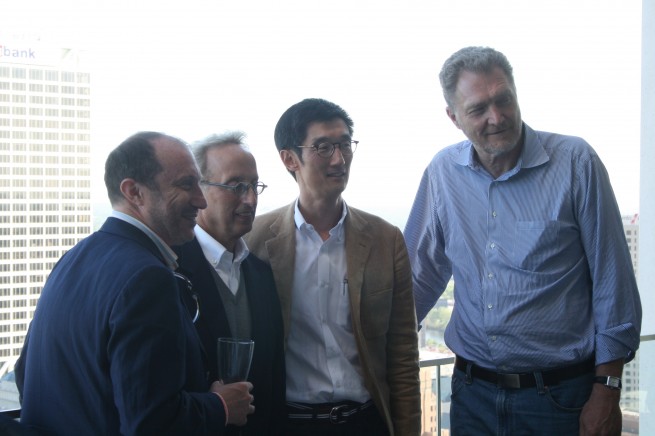
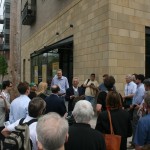
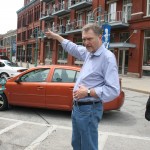
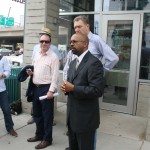
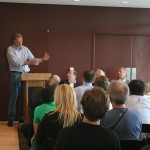
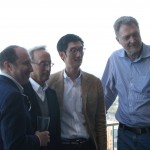
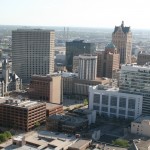
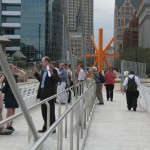
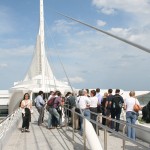
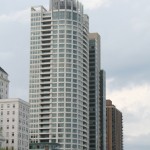
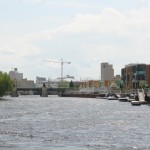
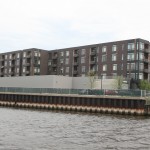
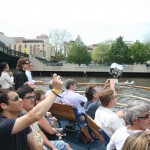
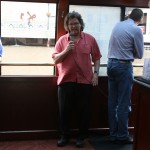
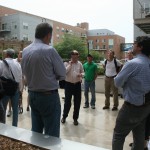
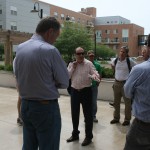




















This is sad. Too bad that some poor life choices, the economy and the “Backwards!” mentality of too many Milwaukeeans did these guys in, but as good as they were, their impact was restricted to the few, the rich, the old, and the childless. No city or culture has ever been built on that. I hope Milwaukee has more than a few “maybes” on healthy neighborhoods in the future, but a lot will have to change for that to happen.
Great synopsis. Doesn’t make me sad at all, I just hope to see Norquist’s vision roll forward. Barret could learn a thing or two.
He hasn’t learned anything so far, no reason to expect that to change. Talent and vision can only play the economic hand they’re dealt too. Banks not lending to the private sector is a problem at the federal level no mayor can affect. Long-term economic contraction as Asia’s star rises is out of anyone’s hands. Recovery from a bubble is not another bubble, but even if you get good growth in real estate again, the NU type of approach only goes so far. Cities that are composed of residential neighborhoods can renew them, bulldoze them, or live with the ruins. The city and county’s handling of areas being renewed by the private sector and their own residents during the Barrett years has been a fat zero to negative. Granted, some people make it hard, but that’s life.
Dan, indeed perhaps. But higher gas prices will certainly help despite any economic contraction. If the bones of the city are good, then people finally getting priced out of the exurban fantasy will start driving (no pun intended) them back to the city. Of course, many people in this silly country would rather start a war than pay reasonable gas prices, but that’s the pessimistic outlook 🙂
It’s not pessimistic at all. It’s exactly what’s been going on, and it will continue.
The higher gas prices=reurbanization meme is interesting but doesn’t have any validity or sense to it. A lot of people live and work outside the city. If their costs go up, they will play less, and that’s the only thing they really do in the city. Higher costs does push more low income people into the city, but is that the growth you’re looking for? If you’re hoping for gas prices so high that middle and upper income exurbanites are pressed into looking for “good bones” in the city, then you’re hoping for the whole metro economy to collapse and spin into the dark world of a Cormac McCarthy novel.
Dan, were you ever optimistic? Is every light at the end of the tunnel, an oncoming train?
I’m not even talking about wearing rose colored glasses, but does every bit of fertilizer have to be a piece of shit?
Wasn’t everyone more optimistic about Milwaukee and the nation itself in the 90s? Things have changed.
There’s good and bad in everything. I’m not sure it what it helps to constantly acknowledge that. It comes off as a refusal to make judgments and admit value differences, the reality of better and worse. Optimism, pessimism, and other -isms are emotional, dogmatic, prejudicial states of mind if you use them as reference points. Would you want pathologists to try to be optimistic in their work? I try to avoid that pitfall when trying to to understand or talk about things, but if I push toward the “pessimistic,” it is to penetrate the relentless optimism of people who think “optimism” will help them determine how close they are to the edge of a cliff. I like calculating possible outcomes conservatively, especially when dealt a bad hand–it’s the best way to know when to take a big risk. There are always moves you can make, but odds are you are going to lose. 😉
Refusing to acknowledge emotion on the basis of rationality is just leaving you with a blind spot, by not attempting to counter that bias. Everyone is human… even pathologists.
Anyway, my attempt at snark and humor were meant to convey ~lighten up, it’s not all bad… even if that’s what you want to think/convey.
I’m totally acknowledging it–just questioning where it’s allowed to exercise an influence, and how, or how much. Glad you were trying to be funny about it. I have a dark sense of humor. No it’s not all bad.
“good growth in real estate again, ”
This does not make an economy strong. real estate was a mirage which coned us into believing that it was a growth industry.
What made Milwaukee strong? It was the Industry which was there from the beginning. Anyone remember the Brewing Industry? Milwaukee was a giant in this. Metal industry. Machining. Allen Bradly etc. It all disappeared into inconsequential form by moving into “cheap” labor parts of the world so that share holders and management could make more.
Remember HOOVER vacuum cleaners. That was a litmus test of how American industry was destroyed and with it good job for American’s. It moved overseas because it couldn’t compete with arrangements set up by BS like NAFTA.
You can’t export houses and grow an economy purely on CREDIT. Hell, this lesson any family would learn once someone in the family is laid off (think – business is moved overseas).